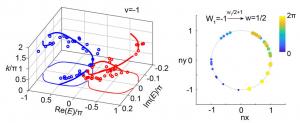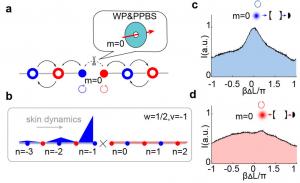The synthetic OAM dimensions contributes to the study of non-Hermitian properties

Figure 1. (a) Schematic of the experimental setup; (b) Illustration of the non-Hermitian synthetic OAM lattice.
GA, UNITED STATES, June 26, 2025 /EINPresswire.com/ -- Non-Hermitian topological systems exhibit a range of unique phenomena that are absent in their Hermitian counterparts. Recently, a team of Chinese scientists constructed a non-Hermitian topological lattice by leveraging the synthetic dimension of orbital angular momentum (OAM). They successfully observed half-integer winding numbers of eigenstates and revealed the corresponding edge states on semi-infinite chains. This work offers a comprehensive understanding of non-Hermitian topology and establishes a novel experimental platform for investigating non-Hermitian phenomena.
In quantum mechanics, observables are typically required to be Hermitian to ensure real eigenvalues. However, physical systems in the real world inevitably interact with their surrounding environment, leading to openness and dissipation, which drives the transition from Hermitian to non-Hermitian systems.The development of non-Hermitian theory has thus provided an elegant and intuitive framework for describing such open systems and non-equilibrium topological phases.
In recent years, a wealth of exotic topological states has been discovered in non-Hermitian systems, sparking significant interest in extending topological concepts beyond Hermitian domains. Compared with traditional Hermitian systems, non-Hermitian topological systems exhibit a range of novel phenomena, such as new topological classifications and the non-Hermitian skin effect. In periodically structured non-Hermitian systems, the complex-valued energy spectrum can display unique winding patterns in the complex plane. Remarkably, the associated topological winding numbers of the eigenstates can take half-integer values—unlike in Hermitian systems, where they are strictly integers. However, directly observing these features, especially the half-integer winding numbers, in experiments has remained a major challenge.
A research team led by Professors Chuan-Feng Li, Jin-Shi Xu, Xi-Wang Luo, and postdoctoral researcher Mu Yang at the University of Science and Technology of China (USTC) has now overcome this obstacle. By constructing a synthetic lattice based on the orbital angular momentum (OAM) degree of freedom, the team successfully realized a non-Hermitian topological lattice and achieved the first direct observation of both the eigenenergy and eigenstate winding behaviors. Most notably, they reported the first experimental observation of half-integer topological winding numbers in a non-Hermitian system and revealed their intrinsic connection to topological boundary states in semi-infinite chains. Their findings were published in Light: Science & Applications under the title "Observing Half-Integer Topological Winding Numbers in Non-Hermitian Synthetic Lattices."
Non-Hermitian topological systems are at the forefront of contemporary physics, featuring phenomena such as complex energy spectra, non-reciprocity, skin effects, and the breakdown of the conventional bulk-boundary correspondence. However, due to limitations in experimental platforms, systematic studies of these effects have lagged behind theoretical progress.
The emerging concept of synthetic dimensions—where internal degrees of freedom like light's frequency, orbital angular momentum, or atomic levels are used to simulate higher-dimensional spaces—has opened new avenues for studying complex non-Hermitian topological systems.
The team built a resonator capable of supporting multiple OAM modes (Fig. 1a). By integrating q-plates and wave plates within the cavity, they induced coupling between the orbital and spin angular momentum (polarization) states. Additional polarization-dependent loss was introduced to realize a non-Hermitian synthetic OAM lattice (Fig. 1b), thereby inducing the non-Hermitian skin effect.
In their experiments, the researchers employed spectral scanning and polarization projection of the output states to simultaneously measure the winding numbers of both the system's eigenenergy and eigenstates (Fig. 2)—a first in experimental studies of non-Hermitian topology.
“Topological winding numbers are not only crucial topological invariants in non-Hermitian systems, but also deeply connected to the system’s underlying symmetries,” said corresponding author Professor Jinshi Xu. “In particular, the half-integer winding number of the eigenstates had never been experimentally observed—until now.”
Dr. Mu Yang, first author of the paper, explained further: “One of the most fascinating aspects of topological materials is the correspondence between topological invariants and boundary states. However, in non-Hermitian systems, the skin effect enhances coupling between lattice edges, disrupting this conventional correspondence.”
To address this, the team strategically broke the coupling at the OAM = 0 position, effectively creating two semi-infinite synthetic lattices (Fig. 3a). Within this configuration, they successfully observed zero-energy boundary states dictated by half-integer winding numbers (Figs. 3b–d)—marking the first experimental demonstration of the correspondence between half-integer topological invariants and boundary states in non-Hermitian systems.
This work represents another significant advance by the team following their earlier achievements published in [Nature Communications, 13, 2040 (2022)], [Science Advances, 9, eabp8943 (2023)], and [Photonics Research, 13, 87 (2025)]. Not only does this study provide the first experimental confirmation of half-integer topological invariants in non-Hermitian systems, it also unveils their physical manifestation in boundary states—laying a vital foundation for future explorations in non-Hermitian topological physics and potential applications in novel photonic devices.
Original Source URL
https://doi.org/10.1038/s41377-025-01909-8
Lucy Wang
BioDesign Research
email us here
Legal Disclaimer:
EIN Presswire provides this news content "as is" without warranty of any kind. We do not accept any responsibility or liability for the accuracy, content, images, videos, licenses, completeness, legality, or reliability of the information contained in this article. If you have any complaints or copyright issues related to this article, kindly contact the author above.


